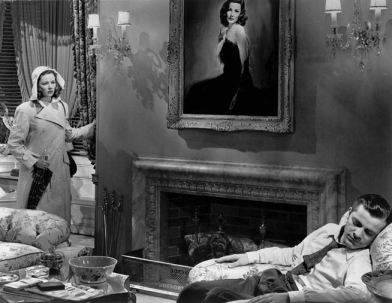I recently started reading a ‘heavy’ tome by feminist academic Susan Felleman, Art in the Cinematic Imagination (University of Texas Press, 2006), and found her discussion of the portrait as a central motif in certain films noir worth sharing.
The portraits, too inert and non narrative to realistically inspire such identification within a realist scenario, threaten the viewer with awareness of the magic of the mimetic and narrative devices employed by the film itself to engage him or her. This is very much a danger in a number of movies in which the portrait assumes a more explicit role and is incorporated into narratives whose realism is strained by, if not abandoned to, psychological or supernatural treatment of mortal desire. In Otto Preminger’s Laura and Fritz Lang’s The Woman in the Window, both from 1944, the male protagonists fall in love with portraits of beautiful women. In Laura, it is ambiguous, at first, when Detective McPherson (Dana Andrews) falls asleep beneath the portrait of Laura (Gene Tierney)—his desire for which has been established—and then awakens to the ‘‘real’’ Laura, presumed dead, whether or not he is dreaming. This ambiguity is a function, as [scholar] Reynold Humphries has indicated, of the uncanny: ‘‘The irruption of Laura the woman into the privileged space of Laura the portrait is not just a question of a return from the dead but rather of a return of the repressed.’’ Humphries aptly relates this to the even more explicit scenario of The Woman in the Window, in which the entire narrative, stemming from Professor Wanley’s fascination with the portrait, is revealed—only finally—as a dream: a dream in which mortal terror and death are conceived as the inevitable outcome of his desire.
Film noir’s peculiar amalgam of sexual angst,morbidity, and the portrait may well find its apogee in another Fritz Lang film, Scarlet Street (1945), in the painfully ironic scene in which the defeated and dispossessed portraitist (Edward G.Robinson) witnesses the sale of what might be called his ‘‘self-portrait as femme fatale,’’ that is, the portrait Chris painted of Kitty ( Joan Bennett) that was exhibited as her self-portrait. The cadaverous image of the woman who stole his meager self-respect, along with the authorship of the painting, and whom he murdered in a fit of sexual jealousy, is borne, funereally, out of the gallery and past the painter, as he shuffles past in a schizophrenic oblivion. The pathological possibilities of mimesis and its subject-object confusions reach so fevered a pitch in Scarlet Street that it’s hard to imagine a sicker scenario…” (pp 17-18).
On reading this passage, the thought came to me, and I don’t claim that I am the first to have had this ‘revelation’, that in Laura, Detective McPherson doesn’t actually wake-up to be greeted by the living Laura but dreams what he subconsciously desires – that Laura is not dead but alive. To this ambiguity challenged by necromancy, add Felleman’s bizarre description of “[his ]self-portrait as femme fatale”!


That’s a really interesting way of looking at it. Thanks for posting this!
LikeLike
The portrait has a head-start so to speak within any thematic interpretation of literature or a film adaptation. One thinks immediately of THE PICTURE OF DORIEN GREY in addition to the aforementioned SCARLET STREET as conforming to the narrative and mimetic devices that the portrait brings to the central themes and issues. Tony, this is really a fascinating read, and it further illustrates where you have taken Films.Noir.net over the past months. It’s no longer a review sight but a place to examine the genre through illuminating prisms. As such it’s a series of extensions that have gloriously negotiated ‘the next step.’
LikeLike
Thanks Diandra.
Sam, your insights are a very welcome addition. Hitchcock’s VERTIGO also comes to mind.
LikeLike
RE: Laura. An ending to the film was shot suggesting that the whole picture was Mark McPherson’s dream, but it was rejected as ineffective. Since the film is narrated by Waldo Lydecker (Clifton Webb) it is hard to take all of it as McPherson’s dream–unless you want to argue that McPherson is also dreaming up Lydecker. I have a chapter on the film in HOLLYWOOD ENIGMA: DANA ANDREWS, which University Press of Mississippi will publish in September.
LikeLike
Thanks for that information and your input Carl.
It could be the Lydecker narration was added after the dream idea was dropped?
Looking forward to your book!
LikeLike